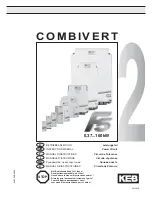
4 Faults and alarms
4.2 List of faults and alarms
SINAMICS G120D
894
List Manual (LH14), 01/2016, A5E33842313
Remedy:
Steps should always be taken to ensure that both motor data identification and the rotating measurement were
carried out (see p1900, r3925).
For closed-loop speed and torque control with speed encoder, the following applies:
- check the speed signal (interrupted cable, polarity, pulse number, broken encoder shaft).
- check the speed encoder, if another speed encoder was selected using the data set changeover. This must be
connected to the same motor that is controlled for the data set changeover.
If there is no fault, then the fault tolerance (p1744 and p0492) can be increased.
For closed-loop speed and torque control without speed encoder, the following applies:
- check whether the drive stalls solely due to the load in controlled mode or when the speed setpoint is still zero. If
yes, then increase the current setpoint using p1610.
- if the motor excitation time (p0346) was significantly reduced and the drive stalls when it is switched on and run
immediately, p0346 should be increased again.
If there is no fault, then the fault tolerance can be increased (p1745).
- check the current limits (p0640, r0067, r0289). If the current limits are too low, then the drive cannot be magnetized.
- if the fault occurs with fault value 2 when the motor accelerates very quickly to the field weakening range, the
deviation between the flux setpoint and flux actual value can be reduced and, in turn, the message prevented, by
reducing p1596 or p1553.
The following generally apply for closed-loop and torque control:
- check whether a line phase failure is affecting power unit PM250D.
- check whether the motor cables are disconnected (see A07929).
If there is no fault, then the delay time can be increased (p2178).
A07903
Drive: Motor speed deviation
Message class:
Application/technological function faulted (17)
Reaction:
NONE
Acknowledge:
NONE
Cause:
The absolute value of the speed difference from the setpoint (p2151) and the speed actual value (r2169) exceeds the
tolerance threshold (p2163) longer than tolerated (p2164, p2166).
The alarm is only enabled for p2149.0 = 1.
Possible causes:
- the load torque is greater than the torque setpoint.
- when accelerating, the torque/current/power limit is reached. If the limits are not sufficient, then it is possible that the
drive has been dimensioned too small.
- for closed-loop torque control, the speed setpoint does not track the speed actual value.
- for active Vdc controller.
For U/f control, the overload condition is detected as the I_max controller is active.
See also: p2149 (Monitoring configuration)
Remedy:
- increase p2163 and/or p2166.
- increase the torque/current/power limits.
- for closed-loop torque control: The speed setpoint should track the speed actual value.
- de-activate alarm with p2149.0 = 0.
A07910 (N)
Drive: Motor overtemperature
Message class:
Motor overload (8)
Reaction:
NONE
Acknowledge:
NONE
Cause:
KTY84/PT1000 or no sensor:
The measured motor temperature or the temperature of the motor temperature model 2 has exceeded the alarm
threshold (p0604). The response parameterized in p0610 becomes active.
PTC or bimetallic NC contact:
The response threshold of 1650 Ohm was exceeded or the NC contact opened.
Alarm value (r2124, interpret decimal):
11: No output current reduction.
12: Output current reduction active.
See also: p0604 (Mot_temp_mod 2/sensor alarm threshold), p0610 (Motor overtemperature response)
















































